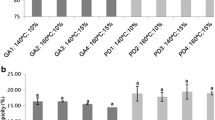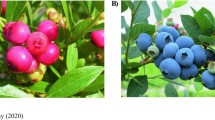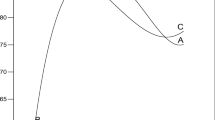Abstract
Elderberry (Sambucus nigra L.), rich in polyphenols, has recently attracted great interest in functional food, nutraceutical, and pharmaceutical industries, due to their potential health benefits to humans. However, polyphenols are very sensitive compounds and unstable. The utilisation of encapsulated polyphenols, instead of free compounds, can overcome some of their limitations. The extraction of the polyphenols from the elderberry flowers and stems was made, followed by the microencapsulation of the extract by a spray drying process. The microparticles were characterised by size, morphology, and release profile. The microencapsulated polyphenols were completely released, with total release times that range from 600 to 1140 s. The kinetic models that have a better adjustment to the practical results are the zero order, the Korsmeyer-Peppas, and the Weibull models, with correlation coefficients that range from 0.900 to 0.999. The encapsulation efficiency was similar for all the analysed particles, being the results located in a range from 92.3 to 99.8%. After 8 months of storage, the microparticles were revaluated, being possible to conclude that the elderberry microparticles present very similar release profiles comparing with the ones obtained with fresh microparticles, which proves the successful encapsulation of the elderberry extract and the stability of the microparticles over time. This experimental work leads to a very successful encapsulation of elderberry extract.




Similar content being viewed by others
References
Ağalar, H. G., Demirci, B., Demirci, F., & Kırımer, N. (2017). The volatile compounds of the elderflowers extract and the essential oil. Records of Natural Products, 11(5), 491–496. https://doi.org/10.25135/rnp.63.16.08.058.
Aguiar, J., Estevinho, B. N., & Santos, L. (2016). Microencapsulation of natural antioxidants for food application - the specific case of coffee antioxidants - a review. Trends in Food Science and Technology, 58, 21–39. https://doi.org/10.1016/j.tifs.2016.10.012.
Aliakbarian, B., Paini, M., & Alberto, A. (2015). Effect of encapsulating agent on physical-chemical characteristics of olive pomace polyphenols-rich extracts. 43, 97–102. https://doi.org/10.3303/CET1543017.
Bakowska-Barczak, A. M., & Kolodziejczyk, P. P. (2011). Black currant polyphenols: their storage stability and microencapsulation. Industrial Crops and Products, 34(2), 1301–1309. https://doi.org/10.1016/j.indcrop.2010.10.002.
Balanc, B., & Trifkovic, K. (2015). Trends in encapsulation technologies for delivery of food bioactive compounds. https://doi.org/10.1007/s12393-014-9106-7.
Bashash, M., Zamindar, N., & Bolandi, M. (2014). Evaluation of antioxidant activities of Iranian sumac (R. coriaria L.) fruit and spice extracts with different solvents. Journal of Food Measurement and Characterization, 8(3), 213–217. https://doi.org/10.1007/s11694-014-9182-7.
Boonchu, T., & Utama-ang, N. (2015). Optimization of extraction and microencapsulation of bioactive compounds from red grape (Vitis vinifera L.) pomace. 52(February), 783–792. https://doi.org/10.1007/s13197-013-1079-7.
Bryła, A., Lewandowicz, G., & Juzwa, W. (2015). Encapsulation of elderberry extract into phospholipid nanoparticles. Journal of Food Engineering, 167, 189–195.
Carlan, I. C., Estevinho, B. N., & Rocha, F. (2017). Study of microencapsulation and controlled release of modified chitosan microparticles containing vitamin B12. Powder Technology, 318, 162–169. https://doi.org/10.1016/j.powtec.2017.05.041.
Carlan, I. C., Estevinho, B. N., & Rocha, F. (2018). Study of different encapsulating agents for the microencapsulation of Vitamin B12. 17(4), 855–864.
Carvalho, I. T., Estevinho, B. N., & Santos, L. (2016). Application of microencapsulated essential oils in cosmetic and personal healthcare products – a review. International Journal of Cosmetic Industry, 38(2), 109–119.
Casanova, F., Estevinho, B. N., & Santos, L. (2016). Preliminary studies of rosmarinic acid microencapsulation with chitosan and modified chitosan for topical delivery. Powder Technology, 297, 44–49. https://doi.org/10.1016/j.powtec.2016.04.014.
Comunian, T. A., Ravanfar, R., Alcaine, S. D., & Abbaspourrad, A. (2018). Water-in-oil-in-water emulsion obtained by glass microfluidic device for protection and heat-triggered release of natural pigments. Food Research International, 106(September 2017), 945–951. https://doi.org/10.1016/j.foodres.2018.02.008.
Consoli, L., Grimaldi, R., Sartori, T., & Menegalli, F. C. (2016). Gallic acid microparticles produced by spray chilling technique : production and characterization. LWT - Food Science and Technology, 65, 79–87.
Costa, D. C., Costa, H. S., Albuquerque, T. G., Ramos, F., Castilho, M. C., & Sanches-silva, A. (2015). Advances in phenolic compounds analysis of aromatic plants and their potential applications. Trends in Food Science & Technology, 45(2), 336–354.
Davidov-pardo, G., & Mcclements, D. J. (2014). Resveratrol encapsulation: designing delivery systems to overcome solubility , stability and bioavailability issues. Trends in Food Science & Technology, 38(2), 88–103.
Dawidowicz, A. L., Wianowska, D., & Baraniak, B. (2006). The antioxidant properties of alcoholic extracts from Sambucus nigra L. (antioxidant properties of extracts). 39, 308–315. https://doi.org/10.1016/j.lwt.2005.01.005.
Dias, M. L., Agüero, L., Zaldivar-silva, D., & Pe, L. (2017). Alginate microparticles as oral colon drug delivery device : a review, 168, 32–43. https://doi.org/10.1016/j.carbpol.2017.03.033
Dong, Y., Martin, K., He, S., & Balling, S. (2017). Gum arabic authentication and mixture quantification by near infrared spectroscopy. Food Control, 78, 144–149.
Đorđević, V., Balanč, B., Belščak-Cvitanović, A., Lević, S., Trifković, K., Kalušević, A., Kostić, I., Komes, D., Bugarski, B., & Nedović, V. (2014). Trends in encapsulation technologies for delivery of food bioactive compounds. Food Engineering Reviews, 7(4), 452–490. https://doi.org/10.1007/s12393-014-9106-7.
Estevinho, B. N., & Rocha, F. (2017). A Key for the Future of the Flavors in Food Industry: Nanoencapsulation and Microencapsulation. In A. E. Oprea & A. M. Grumezescu (Eds.), Nanotechnology Applications in Food: Flavor, Stability, Nutrition and Safety (pp. 1–16). Oxford: Elsevier Inc.. https://doi.org/10.1016/B978-0-12-811942-6.00001-7.
Estevinho, B. N., Damas, A. M., Martins, P., & Rocha, F. (2012). Study of the inhibition effect on the microencapsulated enzyme ttps://doi.org/. Environmental Engineering and Management Journal, 11(11), 1923–1930.
Estevinho, B. N., Rocha, F., Santos, L., & Alves, A. (2013a). Microencapsulation with chitosan by spray drying for industry applications – a review. Trends in Food Science & Technology, 31(2), 138–155. https://doi.org/10.1016/j.tifs.2013.04.001.
Estevinho, B. N., Rocha, F., Santos, L., & Alves, A. (2013b). Using water soluble chitosan for flavour microencapsulation in food industry. Journal of Microencapsulation, 30(6), 571–579. https://doi.org/10.3109/02652048.2013.764939.
Estevinho, B. N., Damas, A. M., Martins, P., & Rocha, F. (2014a). Microencapsulation of 764939nfor flavo with different biopolymers by a spray-drying process. FRIN, 64, 134–140. https://doi.org/10.1016/j.foodres.2014.05.057.
Estevinho, B. N., Damas, A. M., Martins, P., & Rocha, F. (2014b). The influence of microencapsulation with a modified chitosan (water soluble) on b -galactosidase activity. 1575–1586. https://doi.org/10.1080/07373937.2014.909843.
Estevinho, B. N., Ramos, I., & Rocha, F. (2015). Effect of the pH in the formation of galactosidase microparticles produced by a spray-drying process. International Journal of Biological Macromolecules, 78, 238–242. https://doi.org/10.1016/j.ijbiomac.2015.03.049.
Estevinho, B. N., Carlan, I., Blaga, A., & Rocha, F. (2016). Soluble vitamins (vitamin B12 and vitamin C) microencapsulated with different biopolymers by a spray drying process. Powder Technology, 289, 71–78. https://doi.org/10.1016/j.powtec.2015.11.019.
Farooq, M., Sagbas, S., Sahiner, M., Siddiq, M., Turk, M., Aktas, N., & Sahiner, N. (2017). Synthesis , characterization and modification of gum arabic microgels for hemocompatibility and antimicrobial studies. Carbohydrate Polymers, 156, 380–389. https://doi.org/10.1016/j.carbpol.2016.09.052.
Gao, X., Ohlander, M., Jeppsson, N., Bjo, L., & Trajkovski, V. (2000). Changes in antioxidant effects and their relationship to phytonutrients in fruits of sea buckthorn (Hippophae rhamnoides L.) during maturation. 1485–1490.
Gashua, I. B., Williams, P. A., & Baldwin, T. C. (2016). Food hydrocolloids molecular characteristics , association and interfacial properties of gum arabic harvested from both Acacia senegal and Acacia seyal. Food hydrocolloids, 61, 514–522. https://doi.org/10.1016/j.foodhyd.2016.06.005.
Gómez-Mascaraque, L. G., Casagrande Sipoli, C., de La Torre, L. G., & López-Rubio, A. (2017). Microencapsulation structures based on protein-coated liposomes obtained through electrospraying for the stabilization and improved bioaccessibility of curcumin. Food Chemistry, 233, 343–350. https://doi.org/10.1016/j.foodchem.2017.04.133.
Gonçalves, A., Estevinho, B. N., & Rocha, F. (2016). Microencapsulation of vitamin A : a review. Trends in Food Science & Technology, 51, 76–87. https://doi.org/10.1016/j.tifs.2016.03.001.
Gonçalves, A., Estevinho, B. N., & Rocha, F. (2017a). Design and characterization of controlled-release vitamin A microparticles prepared by a spray-drying process. Powder Technology, 305, 411–417. https://doi.org/10.1016/j.powtec.2016.10.010.
Gonçalves, B., Moeenfard, M., Rocha, F., Alves, A., Estevinho, B. N., Santos, L., et al. (2017b). Microencapsulation of a natural antioxidant from coffee - chlorogenic acid (3-caffeoylquinic acid). Food and Bioprocess Technology, 10(8), 1521–1530. https://doi.org/10.1007/s11947-017-1919-y.
Hohnová, B., Šalplachta, J., & Karásek, P. (2017). Pressurized hot water extraction followed by high-performance liquid chromatography for determination of polyphenols in Sambucus nigra L. branches in dependence on vegetative period of the plant. Journal of Food and Nutrition Research, 56(3), 299–303.
Mahdavee Khazaei, K., Jafari, S. M., Ghorbani, M., & Kakhki, H. (2014). Application of maltodextrin and gum arabic in microencapsulation of saffron petalhy for determination of polyphenols in Sambucus nigra L. branche. Carbohydrate Polymers, 105(1), 57–62. https://doi.org/10.1016/j.carbpol.2014.01.042.
Mahdavi, S. A., Jafari, S. M., Ghorbani, M., & Assadpoor, E. (2014). Spray-drying microencapsulation of anthocyanins by natural biopolymers: a review. Drying Technology, 32(5), 509–518. https://doi.org/10.1080/07373937.2013.839562.
Mahdavi, S., Jafari, S., Assadpoor, E., & Dehnad, D. (2016a). Microencapsulation optimization of natural anthocyanins with maltodextrin, gum arabic and gelatin. International Journal of Biological Macromolecules, 85, 379–385. https://doi.org/10.1016/j.ijbiomac.2016.01.011.
Mahdavi, S., Jafari, S., Assadpour, E., & Ghorbani, M. (2016b). Storage stability of encapsulated barberry’s anthocyanin and its application in jelly formulation. Journal of Food Engineering, 181, 59–66. https://doi.org/10.1016/j.jfoodeng.2016.03.003.
Murugesan, R., & Orsat, V. (2011). Spray drying of elderberry (Sambucus nigra L.) juice to maintain its phenolic content. Drying Technology, 29(14), 1729–1740. https://doi.org/10.1080/07373937.2011.602485.
Stănciuc, N., Oancea, A. M., Aprodu, I., Turturică, M., Barbu, V., Ionita, E., et al. (2018). Investigations on binding mechanism of bioactives from elderberry (Sambucus nigra L.) by whey proteins for efficient microencapsulation. Journal of Food Engineering, 223, 197–207. https://doi.org/10.1016/j.jfoodeng.2017.10.019.
Strugała, P., Loi, S., Ba˙zanów, B., Kuropka, P., Kucharska, A. Z., Włoch, A., & Gabrielska, J. (2018). A comprehensive study on the biological activity of elderberry extract and cyanidin 3-O-glucoside and their interactions with membranes and human serum albumin. molecules Article, 23(2566), 1–22. https://doi.org/10.3390/molecules23102566.
Tan, C., Selig, M. J., & Abbaspourrad, A. (2018). Anthocyanin stabilization by chitosan-chondroitin sulfate polyelectrolyte complexation integrating catechin co-pigmentation. Carbohydrate Polymers, 181(August 2017), 124–131. https://doi.org/10.1016/j.carbpol.2017.10.034.
Veberic, R., Jakopic, J., Stampar, F., & Schmitzer, V. (2009). European elderberry (Sambucus nigra L.) rich in sugars, organic acids, anthocyanins and selected polyphenols. Food Chemistry, 114(2), 511–515. https://doi.org/10.1016/j.foodchem.2008.09.080.
Vrchotová, N., Dadáková, E., Matějíček, A., Tříska, J., & Kaplan, J. (2017). Effect of variety on content of bioactive phenolic compounds in common elder (Sambucus nigra L.). Natural Product Research, 31(6), 700–703. https://doi.org/10.1080/14786419.2016.1214826.
Woranuch, S., & Yoksan, R. (2013). Eugenol-loaded chitosan nanoparticles : I . Thermal stability improvement of eugenol through encapsulation. Carbohydrate Polymers, 96(2), 578–585. https://doi.org/10.1016/j.carbpol.2012.08.117.
Funding
This work was financially supported by project UID/EQU/00511/2019 - Laboratory for Process Engineering, Environment, Biotechnology and Energy – LEPABE funded by national funds through FCT/MCTES (PIDDAC); Project POCI-01-0145-FEDER-028715 (MicroDelivery - Development of controlled delivery functional systems by microencapsulation of natural and active compounds with therapeutic, nutritional and technological interest), funded by FEDER funds through COMPETE2020 – Programa Operacional Competitividade e Internacionalização (POCI) and by national funds (PIDDAC) through FCT/MCTES; Project “LEPABE-2-ECO-INNOVATION” – NORTE-01-0145-FEDER-000005, funded by Norte Portugal Regional Operational Programme (NORTE 2020), under PORTUGAL 2020 Partnership Agreement, through the European Regional Development Fund (ERDF). Berta Estevinho acknowledges FCT for the contract based on the “Lei do Emprego Científico” (DL 57/2016).
Author information
Authors and Affiliations
Corresponding author
Ethics declarations
Conflict of Interest
The authors declare that they have no conflicts of interest.
Additional information
Publisher’s Note
Springer Nature remains neutral with regard to jurisdictional claims in published maps and institutional affiliations.
Rights and permissions
About this article
Cite this article
Ribeiro, A.M., Estevinho, B.N. & Rocha, F. Spray Drying Encapsulation of Elderberry Extract and Evaluating the Release and Stability of Phenolic Compounds in Encapsulated Powders. Food Bioprocess Technol 12, 1381–1394 (2019). https://doi.org/10.1007/s11947-019-02304-z
Received:
Accepted:
Published:
Issue Date:
DOI: https://doi.org/10.1007/s11947-019-02304-z




